Art of the Genre: Star Frontiers
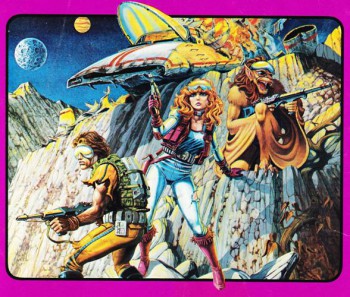
It’s summer intern time here at Black Gate L.A., John having flown in Sue ‘Goth Chick’ Granquist to help break them in. She’s not in love with the beach and the sun, but I must say seeing her in a black one-piece, Jackie-O glasses, and a hat right out of Vampire Hunter D, I had to take a shot with my iPhone because Ryan Harvey [who was struggling with a deadline instead of taking in some sun] would have never believed it otherwise.
That picture, snapped at a moment’s notice, got me thinking about technology and the crazy almost science fiction world we live in. When I was in junior high, way back in the early 80s, my love affair with D&D was in full bloom, and TSR was expanding its brand with new genres like the 1920s prohibition classic Gangbusters, the Bond-like Top Secret, and my personal favorite the space opera Star Frontiers.
When gamers talk about space settings for RPGs they inevitably fall into the defense of GDW’s Traveller as the canon of all things science fiction, but in my case I’ll take the side of Star Frontiers every time.
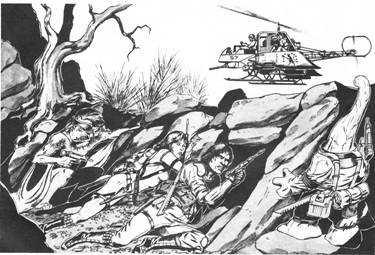
Frontiers, in my opinion, is a ‘clean’ game, which is to say there aren’t any rough edges, shadowed pasts, massive interstellar threats, plagues, or the like. It’s like a perfect joining of Star Trek and Star Wars, where characters find themselves challenged to explore new worlds while still dealing with a handful of alien races as trusted friends.
Only a single enemy truly appears in its pages, the mysterious Sathar, an almost silly worm-like race that can show up to vex players now and then but are never a real threat to galactic society.
There is kind of glamour to Frontiers you don’t find in other games, the shine that comes from Larry Elmore’s first days at TSR. His cover for the Star Frontiers Alpha Dawn boxed set is rivaled only his Dragons of Autumn Twilight classic which should help you envision its power.
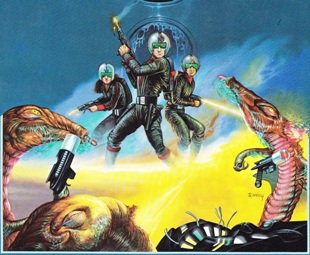
Let’s take a second to deconstruct this cover as it speaks to everything Star Frontiers stands for [click on the above Alpha Dawn cover for a larger version].
First, it’s about a crash. What’s better than crash landing on an alien world, twin moons above, your attack shuttle in flames, and the survivors looking on with guns drawn in case of danger? Well, in my world, nothing, that’s about as good as sci-fi gets and reminds me of my favorite opening to a movie of all time Pitch Black ‘Mr. Johns, blue-eyed devil. Planning on taking me back to slam… …only this time he picked a ghost lane. A long time between stops. A long time for something to go wrong.”
Second, there’s a rocket jockey. This guy looks like you gave a more buff version of Andy Gibb a laser rifle, or better yet Jan Michael Vincent in Damnation Alley. He’s the hero all young boys want to be, and he’s leading the way, point man to adventure as the survivors abandon ship.
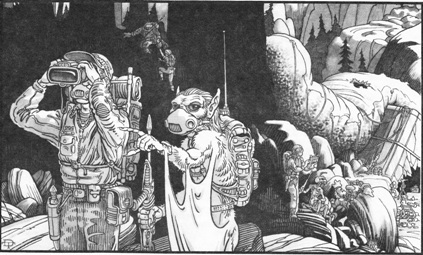
Third, there’s an alien. This is our first glimpse of the Yazirian race, a cross between a monkey and a flying fox, but mostly all attitude, toughness, and teeth. He’s our Chewbacca, the sidekick, human enough to make you comfortable but alien enough to impress the locals.
Fourth, there’s a gorgeous woman who has absolutely no business being in space with a rocket jockey and his alien wingman. Yeah, she’s about as out of place as Sue was in that bathing suit on a beach, yet she is still the focus of the painting. Dressed in 70s spandex and sporting a Katie Perry stomach, our heroine looks like she just stepped off the pages of Vogue instead of a high orbit crash. Goggles tucked up into her strawberry-blonde hair, she’s the epitome of an early Elmore vixen, thin nose, sad little lips, and textbook angled chin. Even the color choice of her clothing is fabulous, the white suit perfectly accessorized with matching colored tassel boots, gloves, adventure vest, communications choker, and holster. And above all, the absolute key to the shot, the rip in her left pant leg that has blemished her otherwise pristine persona says, she’s not perfect. Absolute genius! Oh, and there also needs to be props given to Art Director Jim Rolsof because our female lead is actually stepping out of the framed shot, as though she’s more real to us than anything else pictured, an opening salvo in a psychological war against young boys that strikes home with pinpoint accuracy.
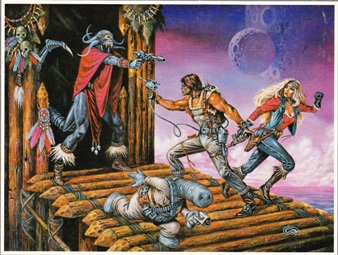
And fifth, and certainly no less important, we see a tangle of brown leaves and vines in the lower right, which counters the blasted rock landscape showing the viewer that there is life on this desolate world. We need this to know that the survivors have a chance, that something lives, and that it’s worth the exploration that is to come.
Ok, so like in Jerry Maguire, ‘you had me at hello’, the cover of Alpha Dawn selling the series without me even cracking a page. That’s the power of great art, and yet Star Frontiers circa 1983 had the fantastic luck of being produced in what many consider the golden age of the TSR art department.
In this game’s pages you witness worlds brought into being by Jim Holloway, Elmore, Jeff Easley, Tim Truman, Dave Trampier, Jim Roslof, Keith Parkinson and finally Clyde Caldwell. Seriously, does it get better than that? And this is the time of these artist’s youth, their creative talent in full bloom as they were still learning, perfecting, and doing work in both color and black and white which kept them fresh and alive.
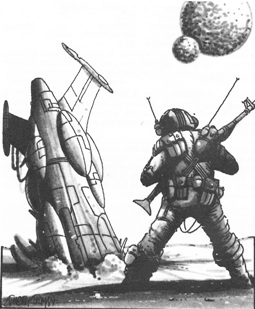
The game is captured frame by frame and Roslof’s art direction keeps the topic tight, the universe held to task and smart, and each world discovered bigger than life.
System mechanics are based on percentiles, an easy enough concept that has better overall ambiguity than D20 where each roll carries a 5% chance of ultimate failure or perfect success. Combat is fun and fast, in typical D&D style, and the adventures are set in the same mold as you’d find in all other fantasy modules from TSR in that day, mostly outpost worlds with surface-born dungeon crawls where a stone labyrinth is replaced with a much more believable treacherous alien landscape.
The Achilles Heel of Star Frontiers, as with any science fiction based game, is still the same, that being a lack of physical reward for PCs. Gamers are ever ready for treasure, be it gold or magic, and that simply can’t be duplicated in science fiction. The game doesn’t overcome this psychological hurdle, high tech gadgets not holding the same appeal as a 10K gold piece gem or a +4 longsword of sharpness, but it does what it can with great settings and ample role-playing possibilities.
This shortfall, however, can’t be blamed on design, and the base Alpha Dawn creates a solid foundation for the larger space opera brought to life in the Knight Hawks expansion box. This newest chapter propelled Frontiers from ground exploration adventures to space combat while adding in a board game wrinkle with cardboard counters.
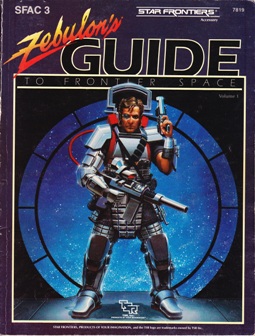
I will go so far as to say that all the above remains window dressing to what truly makes a gaming system great, an effect which I like to refer to as ‘The Unearthed Arcana Principle’. To me, if you want to be a truly memorable game, you need not only produce a strong core book and good adventure supplementation, but also a rules ‘upgrade’ book that becomes almost as important as the core book itself. D&D produced such a volume for 1st Edition in 1985 with Unearthed Arcana, and coincidentally enough, Star Frontiers did the same thing with Zebulon’s Guide to Frontier Space the same year. Basically, you need an Empire Strikes Back or a Godfather II, otherwise you’ve just wasted everyone’s time and money.
Zebulon’s Guide, well, I guess you’d say actually ‘rewrote the book’. Like Unearthed Arcana, it added new races, new items, new ways of looking at the game, and also changes to the game’s mechanics. Sure, there were supposed to be three volumes of the Zebulon’s Guides, and fans might hold the text as incomplete, but gaming isn’t rocket science, and Zebulon’s is still enough of a home run to lip the outfield wall whether it be complete or no.
And speaking of new tech items brought in by Zebulon’s Guide, I fall back again to the beach and my iPhone. When Star Frontiers debuted in 1983 there was heady talk of all kinds of futuristic technology. I was amazed when I saw my character could purchase a wrist computer, which made my calculator watch looking feeble in comparison. Still, Frontiers holds its own, the tech tree involved believable in most aspects, and application to today’s technology isn’t too much of a stretch which is saying something.
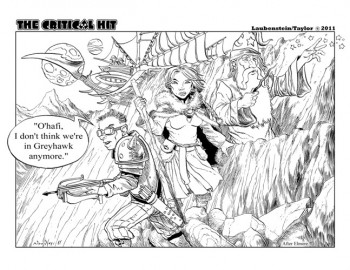
Sadly, after ten adventure modules, two boxed sets, and one guide book, Star Frontiers came to an end in the middle eighties. However, I was keenly happy to see that Wizards of the Coast gave a nod to their old franchise with the release of D20 Future, the trademark races of Frontiers updated in its pages which gave fans a chance to revisit the old United Planetary Federation if they so chose.
So, there you have it, why I think Star Frontiers rules the space lanes of modern RPGs, and also why it’s fun to walk the beaches of L.A. with a Goth Chick even if she’s refused to allow me to post the photo.
Also, I’d like to announce that this will be the final The Critical Hit appearing in Black Gate. The comic has been purchased and will be appearing on another website starting in a few weeks. I’ll keep those informed how might be interested, but right now I can mention no more.
Agreed. My all-time favorite Sci-Fi RPG. The Alpha Dawn cover had me mesemerized as pre-teen.
TDoolan: Well I’m glad I’m not the only one 🙂 If you want to revisit some more Star Frontiers stuff, check out this fan link which is outstanding.
http://www.starfrontiersman.com/
Great article, Scott.
I look forward to the next Critical Hit, wherever it lands.
Dear Scott,
Very nice post and thank you for the invitation to LA. It turned out the be the perfect opportunity to collect bits for new batch of movie-remake-producer voodoo dolls I’ve been working on for some time.
Though the California night life was acceptable, the beach was definitely out of the question. However, I now know the whereabouts of that little poser of an intern who went missing on Saturday afternoon along with my Jackie O sunglasses. Note to self; stop hiring co-eds. The temptation is clearly too much for them.
Now if you’ll excuse me, I have to go back to shaking sand out of my stilettos.
Kisses,
Goth Chick
Blackwell: Thanks for the luck on The Critical Hit
Sue: Well, let me say we’d love to have you back to L.A. anytime, it was certainly as fun as a Goth Chick would allow it to be, and I’m sure I’ll not get that vision of you in the bathing suit out of my head anytime soon. 😉
I had not idea there was so much to Star Frontiers, so thank you for not only showcasing the art and artists, but the different expansions and modules that made up Star Frontiers. I also didn’t know David Trampier was an artist for one of the modules, I’m definitely going to keep my eyes open for that in the future.
Congratulations on the news about Critical Hit! I’m sorry it won’t appear at Black Gate anymore, but I’m excited to learn where it might be going and what you have planned for the future.
For me, this weeks installment of Critical Hit is great in two ways. First, it’s a very nice ‘tip of the hat’ to Mr. Elmore and the Star Frontiers art you showcased. Secondly, what better way to send off Critical Hit from Black Gate to its new home than with a piece that honors the spirit of adventure into the unknown. Here’s wishing you both the best of success with Critical Hit.
Zachary: Ah, my friend, I was wondering where you were this week 😉 Good to see you enjoyed the Star Frontiers art and writing. Trampier did the module [Elmore Cover] SFKH2 [Knight Hawks]: Mutiny on the Eleanor Moraes, which is my second favorite SF module behind SFAD5 [Alpha Dawn]Bugs in the System. Trampier’s art in it is sublime.
Thanks for the congrats on The Critical Hit, but not to worry, I’ll pass along the new link when it goes live, and for you and other comic fans here on BG, ‘Noodles’ and I are going to launch a 2nd comic property concerning gaming right here, so you’ll see that soon if all goes well.
Also, I’m glad you enjoyed the nod to Elmore. One thing no one mentioned was the Spelljammer ship behind the Fleetwood, O’Hafi, and Grumbltash. Of course, there are probably 7 people in the world who actually played Spelljammer, so I suppose that makes sense. 🙂
Scott: Well, better late than never, right?
Spelljammer? I had to look that one up. Once I saw the cover of Spelljammer, distant memories stirred, but I never played it.
I thought the ship was inspired by something from Edgar Rice Burroughs, or maybe Lin Carter, but I guess I was way off the mark. I liked seeing the two NPCs with their distinctive helmets manning the air ship, that was great.
A second comic? Sweet! Until next week,
~Zachary
Zachary: Edgar Rice Burroughs… now that is awesome to think about, and perhaps TSR used ERB as a starting point for Spelljammer, who knows 🙂
Great stuff, Scott! Star Frontiers was my first RPG, and I have most of the art from Alpha Dawn burned into my memory. Always sad it never took off as a game (and Zebulon’s was a tragedy imo).
Recently tracked down a copy of Alpha Dawn out of nostalgia — unpunched! Bought the ‘digitally remastered’ book from lulu as well, I’ll never play, but it’s great just to look at.
Now to track down those Star Frontiers Endless Quest books….
Bill: I was at GenCon last year and Elmore had that Alpha Dawn cover in a poster size… Man I wanted it bad, but alas I have no place to display it 🙁
There’s always the ceiling!
[…] was trying to grab a piece of the rapidly-exploding market with a new game focused on pirates, or science fiction, or the Bronze Age, or the Wild West, King Arthur, horror movies, the fall of Moria, the […]